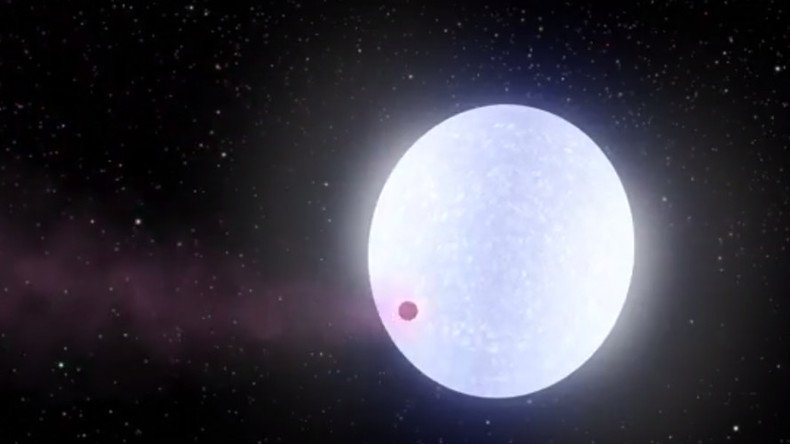Newly-discovered extremely hot planet may have comet-like tail – study

An unbelievable Jupiter like planet that is hotter than most stars and which might contain a comet like tail has been discovered by an international team of scientists.
The discovery shocked even the astronomers themselves, who admitted to questioning whether the scorching world of KELT-9b could possibly be real. Details of the remarkable find have been published in Nature.
The KELT-9b has a day-side temperature of 4,600 Kelvin (more than 7,800 degrees Fahrenheit) – only 1,200 Kelvin (about 2,000 degrees Fahrenheit) cooler than the Sun.
"It is so hot that it is hotter than most stars that we know of out there," said Scott Gaudi, professor of astronomy at The Ohio State University and leader of the study, as cited in NPR.
The gas giant is almost three times more massive than Jupiter but only half as dense. Scientists say this is as a result of the extreme radiation from its host star causing its atmosphere ”to puff up like a balloon.”
“It’s a planet by any of the typical definitions based on mass, but its atmosphere is almost certainly unlike any other planet we’ve ever seen just because of the temperature of its day side,” said Gaudi in a statement.
KELT-9b orbits a star, dubbed KELT-9, which is more than twice as large and nearly twice as hot as the Sun.
Of the thousands of extrasolar planets now known, only six have been found that transit hot, A-type stars (with temperatures of 7,300–10,000 kelvin). No planets are known to transit the even hotter B-type stars.
KELT-9 falls at the dividing line between stars of type A and B with a temperature of 10,170 kelvin.
“KELT-9 radiates so much ultraviolet radiation that it may completely evaporate the planet. Or, if gas giant planets like KELT-9b possess solid rocky cores as some theories suggest, the planet may be boiled down to a barren rock, like Mercury, ” said Keivan Stassun, a professor of physics and astronomy at Vanderbilt who also worked on the study.
‘Hot & steamy’ atmosphere on Earth-like planet GJ 1132b raises hopes of alien life. 👽https://t.co/kevtUlwh9S
— RT UK (@RTUKnews) April 7, 2017
It’s also a possibility that the star could engulf the planet first, with scientists predicting the KELT 9 will become a red giant star in about a billion years.
“The long-term prospects for life, or real estate for that matter, on KELT-9b are not looking good,” Stassun said.
Astronomers using the KELT-North telescope at Winer Observatory in Arizona first noticed a tiny drop in the star’s brightness in 2014, suggesting a planet may have passed in front of it.
Subsequent observations confirmed the signal was as a result of a “hot Jupiter” planet completing it “yearly” circuit every 1.5 days.
READ MORE: Massive ‘hot Jupiter’ has power to ‘spin-up’ own star, scientists claim
The scientists also suspect the planet may even be shedding a tail of evaporated planetary material like a comet and plan to take a closer look with other telescopes, including Spitzer, the Hubble Space Telescope (HST), and eventually the James Webb Space Telescope.













